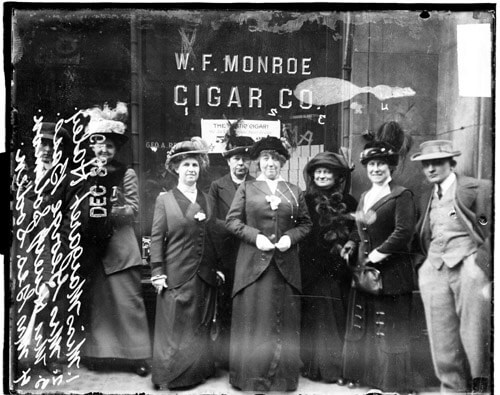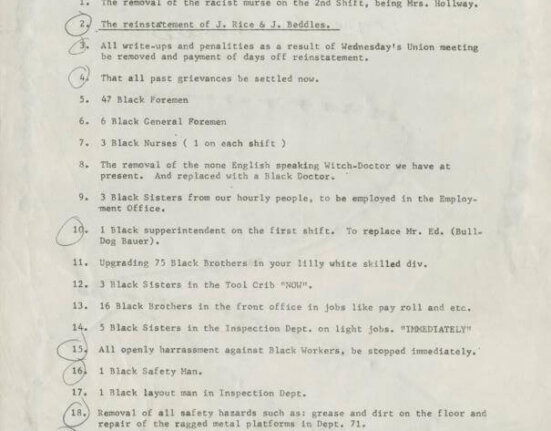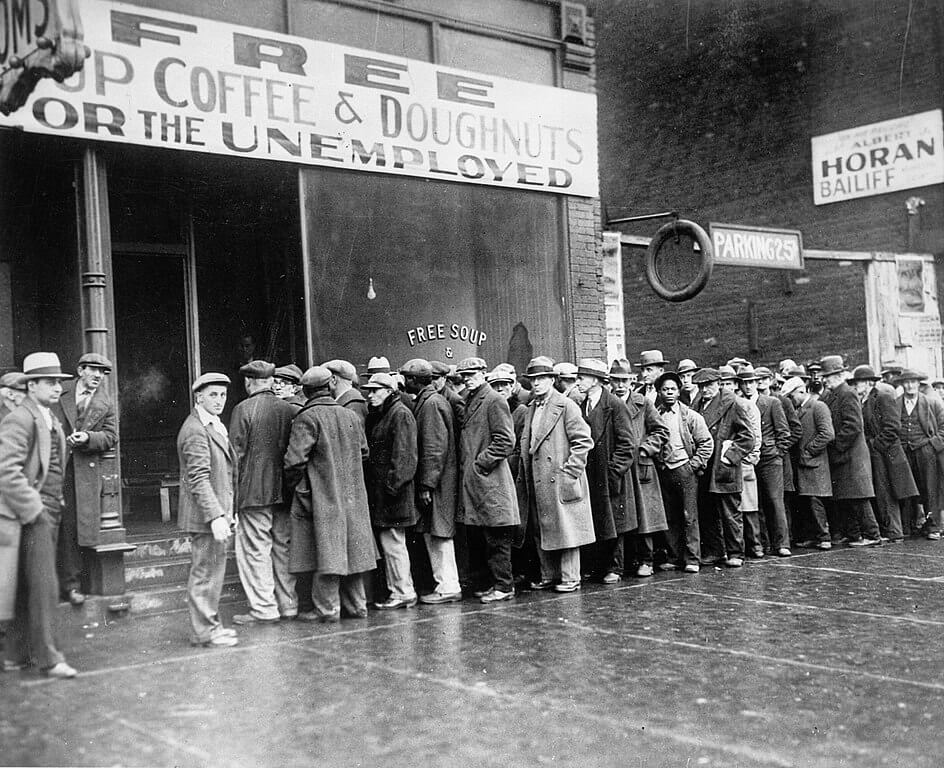Teachers unions have faced some of the most challenging legal strictures in U.S. history. Before public collective bargaining employment laws, teachers effectively were told they had no right to organize by a judicial system that used a variety of constructions of the law to invalidate the citizen’s right to free speech and assembly in the workplace. One illustration of this legal labor history–one relevant to teachers power—is that of the Chicago Teachers’ Federation (CTF) legal battle to overturn the infamous “Loeb rule,’ which presented nearly insurmountable obstacles to the organization of teachers by the labor movement.
Under the administration of Mayor “Big Bill” Thompson, and under the leadership of School Board member and later President, Jacob M. Loeb, the Chicago Board of Education passed a rule in September of 1915 declaring that any teacher who was a member of a trade union or other unauthorized society would not be hired by the Board to work in the schools of Chicago. Rule 93-A, Section 1, read:
“Membership by teachers in labor unions or in organizations of teachers affiliated with a trade union, or a federation or association of trade unions, is inimical to proper discipline, prejudicial to the efficiency of the teaching force, and detrimental to the welfare of the public school system; therefore, such membership or affiliation is hereby prohibited. Membership in some teachers’ organizations which have officers, business agents or other representatives who are not members of the teaching force is inimical to proper discipline, prejudicial to the efficiency of the teaching force, and detrimental to the welfare of the public school system; therefore membership in such said last mentioned organizations as this Board hereafter shall determine are inimical, prejudicial or detrimental as aforesaid is hereby prohibited.”

These types of employer rules were known as “yellow dog” contracts at the time, and were generally produced by employers to prevent union organization. In many cases the courts approved of these types of contracts, presenting tremendous challenges to the labor movement and workers. While “yellow dog” contracts were common, and legal, in the private sector, they were unusual in the public sector, due to the near complete absence of the labor movement in the public sector. Furthermore, a “yellow dog” contract in the public sector had not yet been challenged in court in Illinois at the time of the “Loeb rule.” The CTF decided to challenge this rule in court. CTF President Ida L.M. Fursman, along with the Federation’s attorneys Isaac T. Greenacre and Alice Greenacre, arranged with State’s Attorney Maclay Hoyne to present a complaint in court to prevent the implementation of the rule, and ask for an injunction, on behalf of Fursman, and all of the other taxpayers in Chicago.
The initial judicial response to the complaint was positive for the CTF. In late September, local Superior Court Judge John M. O’Conner issued a temporary injunction preventing the introduction of the rule. In Judge O’Conner’s opinion the rule would give non-union teachers a monopoly in the teaching profession. He reasoned that teachers were members of the union when they were given their contract in June, and for many years prior to the rule, and had not committed any acts detrimental to the schools, so the rule was unreasonable. The legal battle was far from over though. In response to the temporary injunction, the Board sought to have it dissolved, and moved to do so in the court of Superior Court Judge Denis E. Sullivan in October. Sullivan, known in many labor circles of the time as an “injunction judge” for introducing restraining injunctions, was asked to determine the constitutionality of the injunction and the rule. But to the surprise of many Sullivan sided with the CTF. Sullivan was persuaded that the Board had entered into a contract with the teachers in June and couldn’t break the contract by introducing the rule in September, that the Board had no cause to dismiss the teachers, membership in a union was perfectly legal and the teachers had not engaged in any conduct detrimental to the schools. The Board immediately appealed the decision to the Appellate Court, 1st District, which affirmed Sullivan; a permanent injunction against the Board rule was issued in July 1916.
Issac T. Greenacre (right), attorney for the CTF with Judge Michael L. McKinley in late 1922. Greenacre would act as Special Prosecutor in an investigation of corruption in the Chicago Board of Education in late 1922. Judge McKinley handled the case.) The courts were the ultimate arbiter of whether or not teachers were considered workers with rights. From Library of Congress
Issac T. Greenacre (right), attorney for the CTF with Judge Michael L. McKinley in late 1922. Greenacre would act as Special Prosecutor in an investigation of corruption in the Chicago Board of Education in late 1922. Judge McKinley handled the case.) The courts were the ultimate arbiter of whether or not teachers were considered workers with rights. From Library of Congress
It was the Illinois Supreme Court (ISC) that stymied the CTF, in a decision on an appeal by the Board and the city of Chicago which joined them. In an opinion issued April 1917, the court decided that the “Loeb rule” was constitutional, effectively telling them that the 1915 “yellow dog” contract was legal, and teachers seeking employment with the Board would no longer be allowed to be a member of a trade union or other unauthorized group. The court suggested the teachers had not accepted or rejected their contract with the Board until September, and by, “appearing on September 7 and taking up the work assigned, the teachers for the first time signified their acceptance of this offer of employment.” By appearing for work, they had implicitly accepted the rule and their contractual rights were not violated. This left only the issue of whether or not the Board could discriminate against union labor. In the opinion of Justice Cooke, and the majority:
“The board has the absolute right to decline or employ or to re-employ any applicant for any reason whatever or for no reason at all. The board is responsible for its action only to the people of the city, from whom, through the mayor, the members have received appointments. It is no infringement upon the constitutional rights of anyone for the board to decline to employ him as a teacher in the schools, and it is immaterial whether the reason for the refusal to employ him is because the applicant is married or unmarried, is of fair complexion or dark, is or is not a member of a trades union, or whether no reason is given for such refusal. The board is not bound to give any reason for its action. It is free to contract with whomsoever it chooses. Neither the constitution nor the statute places any restriction upon this right of the board to contract, and no one has any grievance which the courts will recognize simply because the board of education refuses to contract with him or her. Questions of policy are solely for determination by the board, and when they have once been determined by it the courts will not inquire into their propriety.”
A few months after the Supreme Court ruling, the Board of Education came to an agreement with the CTF to rehire sixty-six teachers who had resisted the “Loeb rule” and refused to sign the “yellow dog” contract. The teachers were rehired. The CTF also disaffiliated from the CFL and the AFL. During the previous two years, the city administration under Mayor Thompson had come to a different conclusion as to how to relate to the CTF, and this was reflected in the policies of the Board. The CTF had also come to a different conclusion on how to relate to organized labor, and began to chart a new course on its own.
Many theories have been put forward to explain these events: the CTF made a deal with Mayor Thompson to disaffiliate in exchange for rehiring the teachers and dealing with the CTF; the CTF disagreed with the CFL and AFL on American involvement in the war; CTF teachers were eager to disaffiliate because of worries over job losses during the legal struggle. All these serve as possible explanations.
Regardless of what happened, and if there was a deal worked out between the CTF and the Mayor, the Illinois Supreme Court had declared that the Board could formulate any type of contract it wanted with teachers, including a “yellow dog” contract.
This provided a legal foundation that made the struggle for the right to have collective bargaining and other labor rights a primary goal of teachers unions. Legally, the Supreme Court had ruled teachers did not have the right to a union. What they could achieve legally was in the minds of many, different than those of others. The struggle of teachers unions in Chicago in the coming decades would focus on not just changing minds, but also on changing the law. To do so they would have to organize and mobilize the power of teachers.
Further Reading
- George Counts, School and Society in Chicago (New York: Arno Press reprint, 1971).
- Maureen A. Flanagan, Seeing With Their Hearts: Chicago Women and the Vision of the Good City, 1871-1933 (Princeton, NJ: Princeton University Press, 2002).
- Mary J. Herrick, The Chicago Schools: A Social and Political History (Beverly Hills, CA: Sage Publications, 1971).
- David John Hogan, Class and Reform: School and Society in Chicago, 1880-193 (Philadelphia, PA: University of Pennsylvania Press, 1985).
- Georg Leidenberger, Chicago’s Progressive Alliance: Labor and the Bid for Public Streetcars (DeKalb, IL: Northern Illinois University Press, 2006).
- John Lyons, Teachers and Reform: Chicago Public Education, 1929-1970 (Urbana, IL: University of Illinois Press, 2008).
- Marjorie Murphy, “From Artisan to Semi-Professional: White Collar Unionism Among Chicago Public School Teachers, 1870-1930” (PhD diss., University of California, Davis, 1981).
- Marjorie Murphy, Blackboard Unions: the AFT and the NEA, 1900-1980 (Ithaca, NY: Cornell University Press, 1990).
- Robert Louis Reid, “The Professionalization Of Public School Teachers: The Chicago Experience, 1895-1920” (PhD diss., Northwestern University, 1968).
- Robert L. Reid, ed., Battleground: The Autobiography of Margaret Haley (Urbana, IL: University of Illinois Press, 1982.
- Kate Rousmanierie, Citizen Teacher: The Life and Leadership of Margaret Haley (Albany, NY: State University of New York Press, 2005).
- Wayne J. Urban, Why Teachers Organized (Detroit, MI: Wayne State University Press, 1982)
- Julia Wrigley, Class Politics and Public Schools: Chicago, 1900-1950 (New Brunswick, N.J.: Rutgers University Press, 1982)
Note on Sources
For an example of a “yellow-dog” contract ruling, see, Coppage v. Kansas, 236 U.S. 1 (1915). The court case involving the “Loeb rule” is, People ex rel. Ida L.M. Fursman vs. City of Chicago et al., 278 Ill. 318 (1917), the section of the rule cited in the blog is the amended section of the rule passed in late September by the Board and appears in the opinion with the entire rule. For information on a similar case in Ohio, see, Ohio Law Bulletin, Vol. 60, No. 12 (March 22, 1915) pgs. 81-99, Frederick v. Owens, 25 Ohio C.C. (N. S.) 581 (Ohio Ct. App. 1915), and Owens v. Board of Education, 116 N.E. 1085 (Ohio 1916). The opinions of Judge O’Conner, Sullivan, and the Appellate Court, can be found in the Chicago Legal News, Vol. 48, No. 9 (1915-1916), pgs. 100-102 (Judge O’Conner), and Vol. 48, No. 41 (1915-1916), pgs. 483-484 (Appellate Court), and the Brief for the Appellees, Appendix B (Sullivan) and Abstract of Record for the Appellants, pgs. 83-91 (Sullivan), People ex rel. Ida L. M. Fursman vs. City of Chicago et al. case file, Illinois State Archives, Springfield




